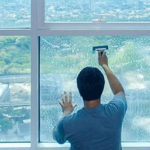
Why Should You Use Heat Protective Paint?
Heat protective paint is a specialized coating designed to reflect heat and keep surfaces cool. It has gained popularity across various industries due to its impressive ability to improve energy efficiency and extend the lifespan of buildings and equipment.
So, why must you use heat protective paint? These paints protect surfaces from high temperatures, reducing thermal damage. By lowering interior temperatures, they reduce energy usage and increase the longevity of structures and machinery.
In this article, we’ll explore why using heat protective paint is a smart choice. We will discuss its benefits, how it works, and why it has become essential for homeowners and businesses alike. Whether you’re looking to save on energy bills or protect your property from the sun’s harsh effects, heat protective paint might be the solution you need.
What is Heat Protective Paint?
Heat protective paint is a specialized coating designed to reflect heat away from surfaces. It uses advanced technology, such as reflective pigments and insulating properties, to reduce the amount of heat absorbed by the material it’s applied to.
The paint’s composition includes tiny particles that reflect sunlight, much like a mirror reflects light. These reflective pigments bounce heat away, keeping surfaces cooler. Additionally, the paint often has insulating properties that further reduce heat transfer, making it highly effective in hot climates.
There are various types of heat protective paints, tailored for different applications:
- Roof Paint: Ideal for cooling roofs and reducing indoor temperatures.
- Wall Paint: Used on exterior walls to prevent heat from entering buildings.
- Industrial Equipment Paint: Protects machinery and equipment from overheating, prolonging their lifespan and improving efficiency.
Key Benefits of Heat Protective Paint
- Energy Efficiency
Heat protective paint significantly reduces heat absorption, keeping surfaces cooler. By reflecting more sunlight, it lowers the need for air conditioning, leading to substantial savings on cooling costs and reduced energy consumption. - Enhanced Comfort
Using heat protective paint helps maintain stable indoor temperatures, making living and working spaces more comfortable. This is especially beneficial in both homes and commercial buildings where temperature control is essential for comfort and productivity. - Protection and Longevity
Heat protective paint acts as a shield against harmful UV rays and weather damage, extending the lifespan of roofs, walls, and other structures by preventing deterioration from sun exposure and harsh weather. - Environmental Impact
By reducing the need for air conditioning, heat protective paint helps lower the overall carbon footprint. It supports sustainability efforts by contributing to energy conservation and reducing greenhouse gas emissions.
Applications of Heat Protective Paint
- Residential Use
Heat protective paint can be applied to various parts of a home, including roofs, exterior walls, attics, and basements. It helps keep homes cooler and more energy-efficient. - Commercial and Industrial Use
In commercial and industrial settings, heat protective paint is used in factories, warehouses, and office buildings. It helps maintain comfortable indoor temperatures and protects large structures and equipment from heat damage. - Special Applications
Beyond buildings, heat protective paint is applied to vehicles, storage tanks, and pipelines to keep them cooler, enhancing their efficiency and longevity.
How to Choose the Right Heat Protective Paint
When selecting heat protective paint, several factors should be considered:
- Type of Surface: Choose a product specifically designed for the surface you are painting, such as a roof, wall, or industrial equipment.
- Climate: In hotter regions, choose a paint with higher reflective properties. In areas with extreme weather, look for additional protective features.
- Budget: While initial costs may vary, investing in a high-quality product can offer long-term savings on energy bills and provide better protection.
- Professional Consultation: Consulting with a professional can help you select the best product and ensure proper application, maximizing the efficiency and lifespan of the paint.
Common Myths and Misconceptions
- Myth: Heat protective paint is only useful in hot climates.
Reality: While highly effective in hot climates, heat protective paint also benefits various weather conditions by reducing heat transfer and maintaining indoor comfort. - Myth: Heat protective paint is expensive and not worth the investment.
Reality: The long-term savings on energy bills and the extended lifespan of protected surfaces often outweigh the initial investment. - Myth: Heat protective paint requires frequent reapplication.
Reality: High-quality heat protective paints, like HeatCure, are designed to last for years with proper application and maintenance. - Myth: Heat protective paint only works on certain surfaces.
Reality: There are heat protective paints available for a variety of surfaces, including roofs, walls, and industrial equipment.
Read more: Top UV Protection in Noida: Protect Your Home with Heatcure
Conclusion
In conclusion, heat protective paint offers unparalleled benefits for both residential and commercial properties. By reflecting sunlight, reducing heat absorption, and enhancing insulation, HeatCure heat-resistant solutions create cooler indoor environments and significantly lower energy consumption. This not only improves comfort but also prolongs the lifespan of buildings and equipment while contributing to environmental sustainability.
We encourage you to explore the benefits of HeatCure for your needs. Whether you want to enhance energy efficiency, improve comfort, or extend the longevity of your property, HeatCure is a reliable and innovative solution. Make the smart choice today—call us at 09134010101 to experience the difference with HeatCure!



Comment (0)